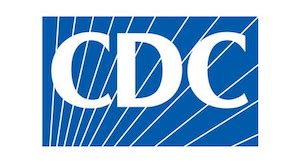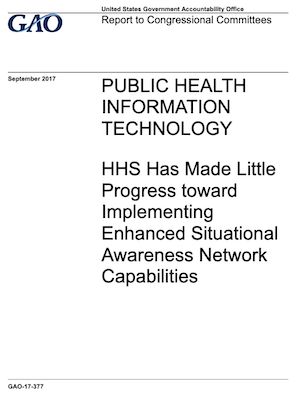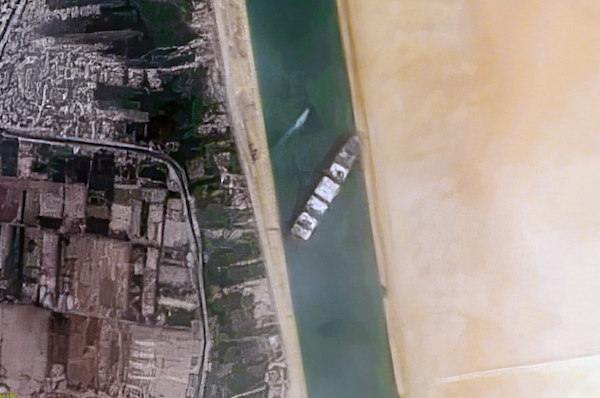pandemics
See the following -
Accelerating Identification and Tracking of Pandemic Disease Outbreaks
 A national biosurveillance program requires the collaboration of multiple federal, state and local agencies to provide a comprehensive view of a health-related event. Bitscopic's Praedico™ biosurveillance platform breaks down the data barriers among organizations with an extensible architecture that can incorporate any kind of data. The platform also delivers high performance by incorporating the latest technologies such as big data, NoSQL databases, and machine learning. Read More »
A national biosurveillance program requires the collaboration of multiple federal, state and local agencies to provide a comprehensive view of a health-related event. Bitscopic's Praedico™ biosurveillance platform breaks down the data barriers among organizations with an extensible architecture that can incorporate any kind of data. The platform also delivers high performance by incorporating the latest technologies such as big data, NoSQL databases, and machine learning. Read More »
- Login to post comments
After Ebola, Liberia’s Health System on Path to Recovery
Shirley Kamara, 37, an expectant mother, smiled as she received medical care at C.H. Rennie Hospital in Kakata, just over 40 miles (68 km) north of Monrovia. “Our hospital is far better now since the Ebola outbreak,” she said. “We are encouraging our people to come here because everything is getting better.” C.H. Rennie Hospital in Liberia’s Margibi County was one of the facilities hardest-hit during the Ebola Virus Disease (EVD) outbreak in 2014; 14 of its health workers died...
- Login to post comments
And We Thought Pandemics Were Bad...Time to Examine The Threat from Microplastics
 The ocean full of microplastics, and fish are as well. They're in our drinking water. Indeed, "There's no nook or cranny on the surface of the earth that won't have microplastics," Professor Janice Brahney told The New York Times. Dr. Brahney was coauthor on a recent study that found microplastics were pervasive even in supposedly pristine parts of the Western U.S. They estimated that 1,000 tons of "plastic rain" falls every year onto protected areas there; 98% of soil samples they took had microplastics. Dr. Brahney pointed out that, because the particles are both airborne and fine, "we're breathing it, too." She admitted: "It's really unnerving to think about it."
The ocean full of microplastics, and fish are as well. They're in our drinking water. Indeed, "There's no nook or cranny on the surface of the earth that won't have microplastics," Professor Janice Brahney told The New York Times. Dr. Brahney was coauthor on a recent study that found microplastics were pervasive even in supposedly pristine parts of the Western U.S. They estimated that 1,000 tons of "plastic rain" falls every year onto protected areas there; 98% of soil samples they took had microplastics. Dr. Brahney pointed out that, because the particles are both airborne and fine, "we're breathing it, too." She admitted: "It's really unnerving to think about it."
- Login to post comments
Blue Ribbon Study Panel On Biodefense Receives $2.5 Million Grant To Reduce Risk of Catastrophic Bioweapon Disease Outbreaks
 The Blue Ribbon Study Panel on Biodefense announced today a $2.5 million grant from the Open Philanthropy Project. The grant allows the Panel to continue its leadership role in assessing our nation’s biodefense, issuing recommendations and advocating for their implementation, and identifying viable avenues for needed change to policy. The grant comes amidst heightened global tensions as North Korea and other regimes seek to develop biological weapons. It also arrives on the 100th anniversary of a catastrophic influenza pandemic that took the lives of millions around the world, a stark reminder of the dangers of biological events.
The Blue Ribbon Study Panel on Biodefense announced today a $2.5 million grant from the Open Philanthropy Project. The grant allows the Panel to continue its leadership role in assessing our nation’s biodefense, issuing recommendations and advocating for their implementation, and identifying viable avenues for needed change to policy. The grant comes amidst heightened global tensions as North Korea and other regimes seek to develop biological weapons. It also arrives on the 100th anniversary of a catastrophic influenza pandemic that took the lives of millions around the world, a stark reminder of the dangers of biological events.
- Login to post comments
CDC Official Protests Federal Medical Response Cuts
More than half a decade of reductions to spending on state and local public-health agencies has already been "extremely damaging" to capabilities across the country for responding to unconventional attacks and other disasters, Dr. Ali Khan, director of the Public Health Preparedness and Response Office at the Centers for Disease Control and Prevention, told Global Security Newswire in an interview.
- Login to post comments
CDC Stands Up New Disease Forecasting Center - To Use Open Source Software and APIs to Expand Data Interoperability
 Today, the Centers for Disease Control and Prevention (CDC) is announcing a new center designed to advance the use of forecasting and outbreak analytics in public health decision making. Once established, the Center for Forecasting and Outbreak Analytics will bring together next-generation public health data, expert disease modelers, public health emergency responders, and high-quality communications, to meet the needs of decision makers. The new center will accelerate access to and use of data for public health decision-makers who need information to mitigate the effects of disease threats, such as social and economic disruption.
Today, the Centers for Disease Control and Prevention (CDC) is announcing a new center designed to advance the use of forecasting and outbreak analytics in public health decision making. Once established, the Center for Forecasting and Outbreak Analytics will bring together next-generation public health data, expert disease modelers, public health emergency responders, and high-quality communications, to meet the needs of decision makers. The new center will accelerate access to and use of data for public health decision-makers who need information to mitigate the effects of disease threats, such as social and economic disruption.
- Login to post comments
Coronavirus and the Recurring Mistake of Fighting the Wrong Wars
 What do the coronavirus and Navy ships have in common? For that matter, what do our military spending and our healthcare spending have in common? More than you might think, and it boils down to this: we spend too much for too little, in large part because we tend to always be fighting the wrong wars.I started thinking about this a couple weeks ago due to a WSJ article about the U.S. Navy's "aging and fragmented technology." An internal Navy strategy memo warned that the Navy is "under cyber siege" by foreign adversaries, leaking information "like a sieve." It grimly pointed out...
What do the coronavirus and Navy ships have in common? For that matter, what do our military spending and our healthcare spending have in common? More than you might think, and it boils down to this: we spend too much for too little, in large part because we tend to always be fighting the wrong wars.I started thinking about this a couple weeks ago due to a WSJ article about the U.S. Navy's "aging and fragmented technology." An internal Navy strategy memo warned that the Navy is "under cyber siege" by foreign adversaries, leaking information "like a sieve." It grimly pointed out...
- Login to post comments
DHS Tries Monitoring Social Media For Signs Of Biological Attacks
The Homeland Security Department has commissioned Accenture to test technology that mines open social networks for indications of pandemics, according to the vendor. Read More »
- Login to post comments
How the Trump Budget Undercuts Security Risks Posed by Pandemics
 President Trump proposed a US$54 billion military budget increase to solidify the security of our nation. However, the government also recognizes pandemic threats as an issue of national security – one that knows no borders. In the last four years, we have faced the Ebola epidemic – contained after significant loss of life – and Zika, which is still not contained. Collectively, we will feel these effects for a generation, while children born with Zika-related defects and their families will feel the effects every day of their lives...
President Trump proposed a US$54 billion military budget increase to solidify the security of our nation. However, the government also recognizes pandemic threats as an issue of national security – one that knows no borders. In the last four years, we have faced the Ebola epidemic – contained after significant loss of life – and Zika, which is still not contained. Collectively, we will feel these effects for a generation, while children born with Zika-related defects and their families will feel the effects every day of their lives...
- Login to post comments
Majority of States Score 6 or Lower Out of 10 Indicators in Report on Health Emergency Preparedness
Washington, D.C., December 19, 2012 – In the 10th annual Ready or Not? Protecting the Public from Diseases, Disasters, and Bioterrorism report, 35 states and Washington, D.C. scored a six or lower on 10 key indicators of public health preparedness. Read More »
- Login to post comments
Mission Essential Solutions
 Mission Essential Solutions, LLC (MES), founded in 2013, offers technical solutions aimed at providing robust mobile capabilities needed for disaster response and recovery operations. James Murphy, President and Owner of the company, is a former Marine helicopter pilot with extensive experience in disaster relief operations, flying humanitarian missions in Puerto Rico and Sierra Leone, and supporting relief operations on the ground following an earthquake and a super typhoon in the Philippines. Before retiring from the Marines in 2012, Mr. Murphy worked at the White House Military Office where he worked in disaster and emergency planning for the President of the United States and the Executive Branch Departments and Agencies.
Mission Essential Solutions, LLC (MES), founded in 2013, offers technical solutions aimed at providing robust mobile capabilities needed for disaster response and recovery operations. James Murphy, President and Owner of the company, is a former Marine helicopter pilot with extensive experience in disaster relief operations, flying humanitarian missions in Puerto Rico and Sierra Leone, and supporting relief operations on the ground following an earthquake and a super typhoon in the Philippines. Before retiring from the Marines in 2012, Mr. Murphy worked at the White House Military Office where he worked in disaster and emergency planning for the President of the United States and the Executive Branch Departments and Agencies.
- Login to post comments
National Biodefense Strategy: Protecting the Nation Against all Biological Threats
 Today, the White House and four federal departments unveiled a comprehensive National Biodefense Strategy to make America safer against modern biological threats to the United States. In the 21st century, biological threats are increasingly complex and dangerous, and that demands that we act with urgency and singular effort to save lives and protect Americans. Whether a natural outbreak, an accidental release, or a deliberate attack, biological threats are among the most serious we face, with the potential for significant health, economic and national security impacts. Therefore, promoting our health security is a national security imperative.
Today, the White House and four federal departments unveiled a comprehensive National Biodefense Strategy to make America safer against modern biological threats to the United States. In the 21st century, biological threats are increasingly complex and dangerous, and that demands that we act with urgency and singular effort to save lives and protect Americans. Whether a natural outbreak, an accidental release, or a deliberate attack, biological threats are among the most serious we face, with the potential for significant health, economic and national security impacts. Therefore, promoting our health security is a national security imperative.
- Login to post comments
Overdue Outbreak Detection System Leaves Patchwork Defense
 The U.S. should have had a nationwide network to monitor for the next viral outbreak or biological threat a decade ago. It still doesn't. Instead, public health leaders make do with a patchwork system while waiting for the Department of Health and Human Services races to get its integrated network in service by a new 2023 congressional deadline. Until that nationwide monitoring system is in place, the U.S. runs the risk that a biological threat like a disease outbreak will take hold before it's noticed. "The risk is that we don't have the level of surveillance that we need. The risk is that there are things basically flying under the radar," said Helen Boucher, an infectious diseases clinician at Tufts Medical Center in Boston and director of the university's Center for Integrated Management of Antimicrobial Resistance.
The U.S. should have had a nationwide network to monitor for the next viral outbreak or biological threat a decade ago. It still doesn't. Instead, public health leaders make do with a patchwork system while waiting for the Department of Health and Human Services races to get its integrated network in service by a new 2023 congressional deadline. Until that nationwide monitoring system is in place, the U.S. runs the risk that a biological threat like a disease outbreak will take hold before it's noticed. "The risk is that we don't have the level of surveillance that we need. The risk is that there are things basically flying under the radar," said Helen Boucher, an infectious diseases clinician at Tufts Medical Center in Boston and director of the university's Center for Integrated Management of Antimicrobial Resistance.
- Login to post comments
We've Been Looking At The Spread Of Global Pandemics All Wrong
Five hundred years ago, the spread of disease was largely constrained by the main mode of transportation of the time: people traveling on foot. An outbreak in one town would slowly ripple outward with a pattern similar to what occurs when a rock drops onto a surface of still water...Today, disease migrates across populations and geography with a curiously different pattern. Read More »
- Login to post comments
What Can We Learn from a Big Boat Stuck in a Canal?
 ...The answer to addressing the problem of thinned out supply chains is to recognize that hyper-efficient globalization inherently carries the downside of unpredictable shortages, geopolitical tension, and supply disruptions. And then redesign our global trading order to make it less efficient and more resilient. There are three basic changes we'll need. First, we need to restore anti-monopoly rules, such as antitrust, to prevent the consolidation of production and distribution in the first place. Second, we should re-impose friction, like tariffs, in global trading so that we relocalize production. Trade is generally a good thing, but every country or geographic bloc should be able to provide itself with the essentials, in case there are disruptions. Third, we should rapidly restructure the way that firms finance themselves, so that they have less debt. Debt is a cruel taskmaster, and it leads CEOs to cut deeply not just into fat but into muscle and bone.
...The answer to addressing the problem of thinned out supply chains is to recognize that hyper-efficient globalization inherently carries the downside of unpredictable shortages, geopolitical tension, and supply disruptions. And then redesign our global trading order to make it less efficient and more resilient. There are three basic changes we'll need. First, we need to restore anti-monopoly rules, such as antitrust, to prevent the consolidation of production and distribution in the first place. Second, we should re-impose friction, like tariffs, in global trading so that we relocalize production. Trade is generally a good thing, but every country or geographic bloc should be able to provide itself with the essentials, in case there are disruptions. Third, we should rapidly restructure the way that firms finance themselves, so that they have less debt. Debt is a cruel taskmaster, and it leads CEOs to cut deeply not just into fat but into muscle and bone.
- Login to post comments